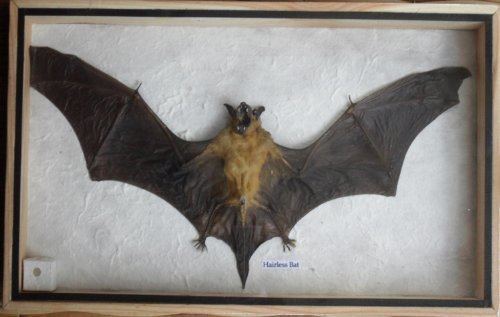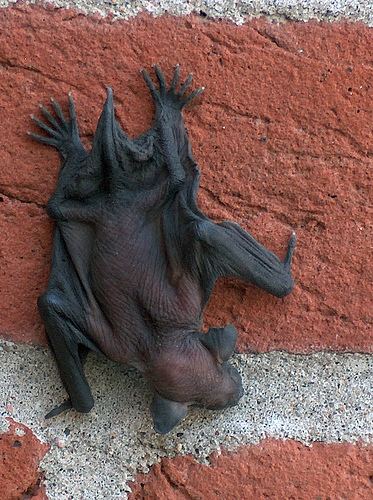Order Chiroptera Higher classification Cheiromeles | Phylum Chordata Family Molossidae Scientific name Cheiromeles torquatus Rank Species | |
 | ||
Similar Cheiromeles, Bat, Mammal, Free‑tailed bat, Lesser sheath‑tailed bat | ||
The hairless bat (Cheiromeles torquatus), also called the naked bulldog bat and greater naked bat, is a species of bat in the family Molossidae. Often recognized as bulldog bat for its appearance similar to bulldogs. The genus 'Cheiromeles' comes from greek word cheir (Greek for hand) and Species name is derived from Latin torques (latin for collar).
Contents

This bat is a hawking insectivore, using echolocation to find insects on the wing.
The hairless bat is mostly hairless, but does have short, bristly hairs around its neck, on its front toes, and around the throat sac, along with fine hairs on the head and tail membrane.

Habitat, Distribution and Range

This species is pre-dominantly concentrated in the South East Asian regions of Myanmar, Indonesia, Malaysia, Java, Thailand, [Sumatra] and [Borneo]. Some of it are also found in the Island surrounding Philippines. There is no current estimate of population size as it is highly dispersed and found in rarity. It inhabits mainly lowlands, marshes, rocky surfaces with holes and crevices, dens, farms and trees. This species of bats are social so they roost in large groups of colonies to reserve food resources. It is typically harmless but is considered a pest in some rice growing areas.
Description

This hairless species of bats that belong to family Molossidae has remarking features that makes them unique compared to other bat species. One of the distinguishable feature is the tail size which is longer than their hind limb. Its remarking dark grey skin which is devoid of hair but may have some fine patches of hair around the throat and under hind foot. They scent mark their territories by secretion from pores known as secretory glands located at the tip of the neck. Sometimes these secretory glands have sub maxillary pouches located either inside the ears or beneath the neck region used for 'brooding ' and 'nursing' purposes. They are the only species of bats that uses all four limbs to accomplish full range of movement, it is done so by acquiring pouches with tiny folds located on either side of the body. Amongst other bat species, hairless bat possess a broad face, robust jaw, wide wings and protruding tail thus having an overall thick body structure. Their first toe bears nails rather than claws which is opposable against its hind toes. The dental formula is 1/1, 1/1, 1/2, 3/2 consisting of small incisors and a diastema forms between upper and lower incisors. They use echolocation to catch their preys and use alarm calls to their roosting members for any approach of danger.
Reproduction

C.torquatus produces average of only two litters a year and as soon as they are born, the mothers do not nurture them in her pouch but rather leave them with the roosting members to embark for their own survival. Usually the mothers would carry the young ones until maturity but only when food resources are abundant. Sexual dimorphism is inherent in which males are darker and bigger than females but sometimes females also exhibit darker coloration. Males typically do not invest in parental care and hence participate in roosting behaviors.
Behavior
C.torquatus is the only social bat species that utilizes majority time in roosting services. They are nocturnal, extremely migratory and colonial. Hunting starts early in the morning where they leave their roost and begin preying on larger insects compared to other small bats who cannot. On their hunting grounds, they develop precautionary skills to protect against predators, echolocation is used whilst this behavior.
Threats
Recently C.torquatus population is decreasing due to roost sites being destroyed and habitat fragmentation is causing them to relocate at different regions resulting in isolation from roosting population. Some indigenous Malay people eat these bats as delicacy and killing them in abundance. This is drastically reducing the overall population of these bats making them vulnerable to being almost threatened.
Conservation Actions
Despite their contribution in pest control, their population has been at stake recently. Population recovery is availed in some regions and some are placed in protected areas with ongoing habitat reconstruction as well as educating indigenous people about bat's importance.
